Impact of the Mining Process on the Near-Seabed Environment of a Polymetallic Nodule Area: A Field Simulation Experiment in a Western Pacific Area
Abstract
:1. Introduction
2. Methods
2.1. Experiment Site
2.2. In Situ Observation Device
2.3. Experimental Process
3. Results
3.1. The Change Process of the Current’s Direction near the Bottom Bed
3.2. Process of Variation in Suspended Sediments near the Bottom Bed
4. Discussion
4.1. Effects of Sediment Resuspension on Sediment Flux
4.2. The Effect of Sediment Resuspension on Salinity and Water Concentration Anomaly
4.3. Effects of the Deep Reciprocating Current on the Near-Seabed Environment
5. Conclusions
Author Contributions
Funding
Institutional Review Board Statement
Informed Consent Statement
Data Availability Statement
Acknowledgments
Conflicts of Interest
References
- Hein, J.R.; Koschinsky, A.; Kuhn, T. Deep-ocean polymetallic nodules as a resource for critical materials. Nat. Rev. Earth Environ. 2020, 1, 158. [Google Scholar] [CrossRef]
- Hein, J.R.; Mizell, K.; Koschinsky, A.; Conrad, T.A. Deep-ocean mineral deposits as a source of critical metals for high- and green-technology applications: Comparison with land-based resources. Ore Geol. Rev. 2013, 51, 1. [Google Scholar] [CrossRef]
- Glasby, G.P. Lessons Learned from Deep-Sea Mining. Science 2000, 289, 551–553. [Google Scholar] [CrossRef]
- Miller, K.A.; Thompson, K.F.; Johnston, P.; Santillo, D. An overview of seabed mining including the current state of development, environmental impacts, and knowledge gaps. Front. Mar. Sci. 2018, 4, 418. [Google Scholar] [CrossRef]
- Amos, A.F.; Roels, O.A. Environmental aspects of manganese nodule mining. Mar. Pol. 1977, 1, 156–163. [Google Scholar] [CrossRef]
- Hirota, J. Potential effects of deep-sea minerals mining on macrozooplankton in the north equatorial pacific. Mar. Min. 1981, 3, 19–57. [Google Scholar]
- Ozturgut, E.; Lavelle, J.W.; Burns, R.E. Impacts of manganese nodule mining on the environment: Results from pilot-scale mining tests in the north equatorial pacific. Elsevier Oceanogr. Ser. 1981, 27, 437–474. [Google Scholar]
- Trueblood, D.D. US Cruise Report for BIE Ⅱ, Cruise Ⅰ, 10 April–29 May 1992; National Oceanic and Atmospheric Administration, National Ocean Service: Washington, DC, USA, 1992.
- Petersen, S.; Krätschell, A.; Augustin, N.; Jamieson, J.; Hein, J.R.; Hannington, M.D. News from the seabed—Geological characteristics and resource potential of deep-sea mineral resources. Mar. Pol. 2016, 70, 175–187. [Google Scholar] [CrossRef]
- Toro, N.; Robles, P.; Jeldres, R.I. Seabed mineral resources, an alternative for the future of renewable energy: A critical review. Ore Geol. Rev. 2020, 126, 103699. [Google Scholar] [CrossRef]
- Roy, S.; Dasgupta, S.; Mukhopadhyay, S.; Fukuoka, M. Atypical ferromanganese nodules from pelagic areas of the Central Indian Basin, equatorial Indian Ocean. Mar. Geol. 1990, 92, 269–283. [Google Scholar] [CrossRef]
- Beaudoin, Y.C.; Baker, E. Deep Sea Minerals: Manganese Nodules, a Physical, Biological, Environmental and Technical Review; Secretariat of the Pacific Community: Paris, France, 2013. [Google Scholar]
- Beaudoin, Y.; Bredbenner, A.; Baker, E.; Roche, C.; Bice, S.; Pendletone, L. Wealth in the Oceans: Deep sea mining on the horizon? Environ. Dev. 2014, 12, 50–61. [Google Scholar]
- Liu, Y.G.; Ren, J.B.; Deng, Y.N.; Lai, P.X.; He, G.W. Geochemical characteristics and genesis of polymetallic nodules in the investigation area in Pacific. Earth Sci. Front. 2020, 28, 412–425. (In Chinese) [Google Scholar]
- Mel’nikov, M.E.; Avdonin, V.V.; Pletnev, S.P.; Sedysheva, T.E. Buried ferromanganese nodules of the Magellan Seamounts. Lithol. Miner. Resour. 2016, 51, 1–12. [Google Scholar] [CrossRef]
- Von Stackelberg, U. Growth history of manganese nodules and crusts of the Peru Basin. Geol. Soc. Spec. Publ. 2015, 119, 153–176. [Google Scholar] [CrossRef]
- Liang, D.; He, G.; Zhu, K. The small-scale distributing characteristics of the polymetallic nodules in the west china example area. Acta Oceanol. Sin. 2014, 36, 33–39. (In Chinese) [Google Scholar]
- Li, Z.; Li, H.; Hein, J.R.; Dong, Y.; Wang, M.; Ren, X.; Wu, Z.; Li, X.; Chu, F. A possible link between seamount sector collapse and manganese nodule occurrence in the abyssal plains, NW Pacific Ocean. Ore Geol. Rev. 2021, 138, 104378. [Google Scholar] [CrossRef]
- Tao, C.; Li, H.; Jin, X.; Zhou, J.; Wu, T.; He, Y.; Deng, X.; Gu, C.; Zhang, G.; Liu, W. Seafloor hydrothermal activity and polymetallic sulfide exploration on the southwest Indian ridge. Chin. Sci. Bull. 2014, 59, 2266–2276. [Google Scholar] [CrossRef]
- Lv, W.Z.; Hua, Y.X.; Zhang, G.Z.; Bao, G.S. Geology of the China Pioneer Area of Polymetallic Nodule Deposit in the Pacific Ocean; China Ocean Press: Qingdao, China, 2008. (In Chinese) [Google Scholar]
- Kim, S.; Cho, S.; Lim, W.; Lee, T.H.; Park, S.; Hong, S.; Kim, H.; Min, C.; Choi, J.; Ko, Y.; et al. Probability distribution for size and mass of a nodule in the KR5 area for the development of a manganese nodule miner. Ocean Eng. 2019, 171, 131–138. [Google Scholar] [CrossRef]
- Kersten, O.; Vetter, E.W.; Jungbluth, M.J.; Smith, C.R.; Goetze, E. Larval assemblages over the abyssal plain in the Pacific are highly diverse and spatially patchy. PeerJ 2019, 7, e7691. [Google Scholar] [CrossRef]
- Laroche, O.; Kersten, O.; Smith, C.R.; Goetze, E. Environmental DNA surveys detect distinct metazoan communities across abyssal plains and seamounts in the western Clarion-Clipperton zone. Mol. Ecol. 2020, 29, 4588–4604. [Google Scholar] [CrossRef]
- Huang, H.; Wang, L.; Ou, D.; Li, W.; Kuang, F.; Lin, C.; He, X.; An, L.; Wang, W. A preliminary evaluation of some elements for designation of preservation and impact reference zones in deep sea in the Clarion-Clipperton Zone: A case study of the China ocean mineral resources association contract area. Ocean. Coal Man. 2020, 188, 105135. [Google Scholar]
- Wu, Y.; Liao, L.; Wang, C.; Ma, W.; Meng, F.; Min, W.; Xu, W. A comparison of microbial communities in deep-sea polymetallic nodules and the surrounding sediments in the Pacific Ocean. Deep Sea Res. Part I 2013, 79, 40–49. [Google Scholar] [CrossRef]
- Mestre, N.C.; Rocha, T.L.; Canals, M.; Danovaro, R.; Dell’Anno, A.; Gambi, C.; Regoli, F.; Sanchez-Vidal, A.; Bebianno, M.J. Environmental hazard assessment of a marine mine tailings deposit site and potential implications for deep-sea mining. Environ. Pollut. 2017, 228, 169–178. [Google Scholar] [CrossRef]
- Montserrat, F.; Guilhon, M.; Corrêa, P.V.F.; Bergo, N.M.; Signori, C.N.; Tura, P.M.; Maly, M.D.; Moura, D.; Jovane, L.; Pellizari, V.; et al. Deep-sea mining on the Rio Grande Rise (Southwestern Atlantic): A review on environmental baseline, ecosystem services and potential impacts. Deep Sea Res. Part I Oceanogr. Res. Pap. 2019, 145, 31–58. [Google Scholar] [CrossRef]
- Kaikkonen, L.; Venesjärvi, R.; Nygård, H.; Kuikka, S. Assessing the impacts of seabed mineral extraction in the deep sea and coastal marine environments: Current methods and recommendations for environmental risk assessment. Mar. Pollut. Bull. 2018, 135, 1183–1197. [Google Scholar] [CrossRef]
- Caras, T.; Pasternak, Z. Long-term environmental impact of coral mining at the Wakatobi marine park, Indonesia. Ocean. Coast. Manag. 2009, 52, 539–544. [Google Scholar] [CrossRef]
- Oh, J.W.; Jung, J.Y.; Hong, S. On-board measurement methodology for the liquid-solid slurry production of deep-seabed mining. Ocean Eng. 2018, 149, 170–182. [Google Scholar] [CrossRef]
- Cho, S.G.; Park, S.; Oh, J.; Min, C.; Kim, H.; Hong, S.; Jang, J.; Lee, T.H. Design optimization of deep-seabed pilot miner system with coupled relations between constraints. J. Terramechanics 2019, 83, 25–34. [Google Scholar] [CrossRef]
- Ma, W.; Rao, Q.; Li, P.; Guo, S.; Feng, K. Shear creep parameters of simulative soil for deep-sea sediment. J. Cent. South Univ. 2014, 21, 4682–4689. [Google Scholar] [CrossRef]
- Dai, Y.; Xue, C.; Su, Q. An integrated dynamic model and optimized fuzzy controller for path tracking of deep-sea mining vehicle. J. Mar. Sci. Eng. 2021, 9, 249. [Google Scholar] [CrossRef]
- Eva, R.L.; Hilde, C.T.; Anita, E.; Lisa, A.L.; Malin, A.; Tor, E.F.; Ana, H.; Belinda, F.; Guttorm, C.; Morten, S.; et al. Submarine and deep-sea mine tailing placements: A review of current practices, environmental issues, natural analogs and knowledge gaps in Norway and internationally. Mar. Pollut. Bull. 2015, 97, 13–35. [Google Scholar]
- Gausepohl, F.; Hennke, A.; Schoening, T.; Köser, K.; Greinert, J. Scars in the abyss: Reconstructing sequence, location and temporal change of the 78 plough tracks of the 1989 discol deep-sea disturbance experiment in the Peru Basin. Biogeosciences 2020, 17, 1463–1493. [Google Scholar] [CrossRef]
- Sharma, R. Deep-sea impact experiments and their future requirements. Mar. Georesources Geotechnol. 2013, 23, 331–338. [Google Scholar] [CrossRef]
- Vonnahme, T.R.; Molari, M.; Janssen, F.; Wenzhöfer, F.; Haeckel, M.; Titschack, J.; Boetius, A. Effects of a deep-sea mining experiment on seafloor microbial communities and functions after 26 years. Sci. Adv. 2020, 6, 5922. [Google Scholar] [CrossRef] [PubMed]
- Sharma, R.; Sankar, S.J.; Samanta, S.; Sardar, A.A.; Gracious, D. Image analysis of seafloor photographs for estimation of deep-sea minerals. Geo-Mar. Lett. 2010, 30, 617–626. [Google Scholar] [CrossRef]
- Perelman, J.N.; Firing, E.; Grient, J.M.A.V.D.; Jones, B.A.; Drazen, J.C. Mesopelagic scattering layer behaviors across the Clarion-Clipperton Zone: Implications for deep-sea mining. Front. Mar. Sci. 2021, 8, 632764. [Google Scholar] [CrossRef]
- Kang, Y.; Liu, S. The development history and latest progress of deep-sea polymetallic nodule mining technology. Minerals 2021, 11, 1132. [Google Scholar] [CrossRef]
- Fan, Z.; Jia, Y.; Chu, F.; Zhu, X.; Zhu, N.; Li, B.; Quan, Y. Effects of migration and diffusion of suspended sediments on the seabed environment during exploitation of deep-sea polymetallic nodules. Water 2022, 14, 2073. [Google Scholar] [CrossRef]
- Qiu, Z.; Ma, W.; Tao, C.; Koschinsky, A.; Hu, S. Clay minerals and Sr-Nd isotope compositions of core cg 1601 in the northwest pacific: Implications for material source and rare earth elements enrichments. Minerals 2022, 12, 287. [Google Scholar] [CrossRef]
- Peng, J. Development of research on deep-sea polymetallic nodule mining vehicle in China. Min. Process. Equip. 2020, 48, 20–23. (In Chinese) [Google Scholar]
- Li, X.; Cheng, Y.; Zheng, H.; Liang, Z. Simulation Analysis of the Mobility of “Kunlong 500” Deep Sea Crawler Collector. Min. Metall. Eng. 2020, 40, 1–4. (In Chinese) [Google Scholar]
- Drazen, J.C.; Smith, C.R.; Gjerde, K.M.; Haddock, S.H.; Carter, G.S.; Choy, C.A.; Clark, M.R.; Dutrieux, P.; Goetze, E.; Hauton, C.; et al. Opinion: Midwater ecosystems must be considered when evaluating environmental risks of deep-sea mining. Proc. Natl. Acad. Sci. USA 2020, 117, 17455–17460. [Google Scholar] [CrossRef]
- Tian, Z.; Liu, C.; Jia, Y.; Song, L.; Zhang, M. Submarine Trenches and Wave-Wave Interactions Enhance the Sediment Resuspension Induced by Internal Solitary Waves. J. Ocean. Univ. China 2023, 22, 1–10. [Google Scholar] [CrossRef]
- Tian, Z.; Jia, L.; Xiang, J.; Yuan, G.; Yang, K.; Wei, J.; Zhang, M.; Shen, H.; Yue, J. Excess pore water pressure and seepage in slopes induced by breaking internal solitary waves. Ocean Eng. 2023, 267, 113281. [Google Scholar] [CrossRef]
- Tian, Z.; Jia, Y.; Chen, J.; Liu, P.; Zhang, S.; Ji, C.; Liu, X.; Shan, H.; Shi, X.; Tian, J. Internal solitary waves induced deep-water nepheloid layers and seafloor geomorphic changes on the continental slope of the northern South China Sea. Phys. Fluids 2021, 33, 053312. [Google Scholar] [CrossRef]
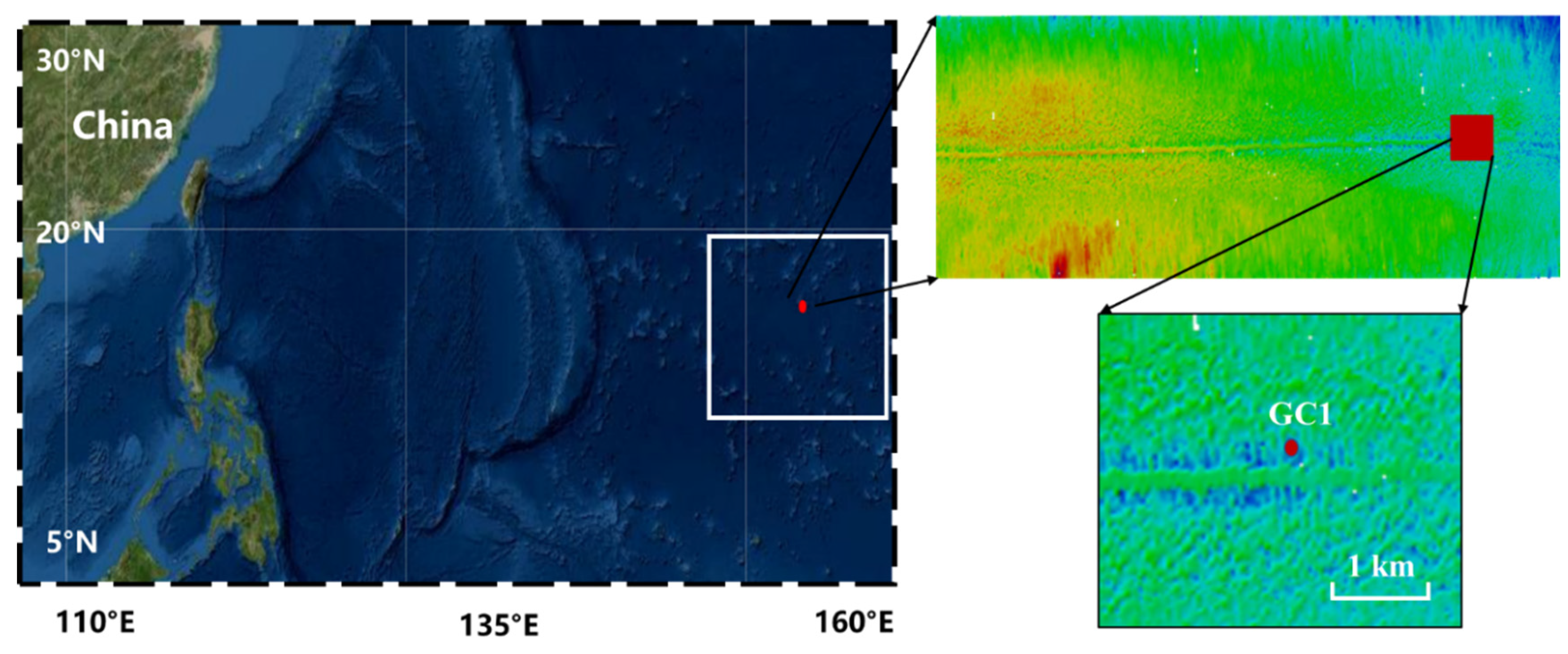
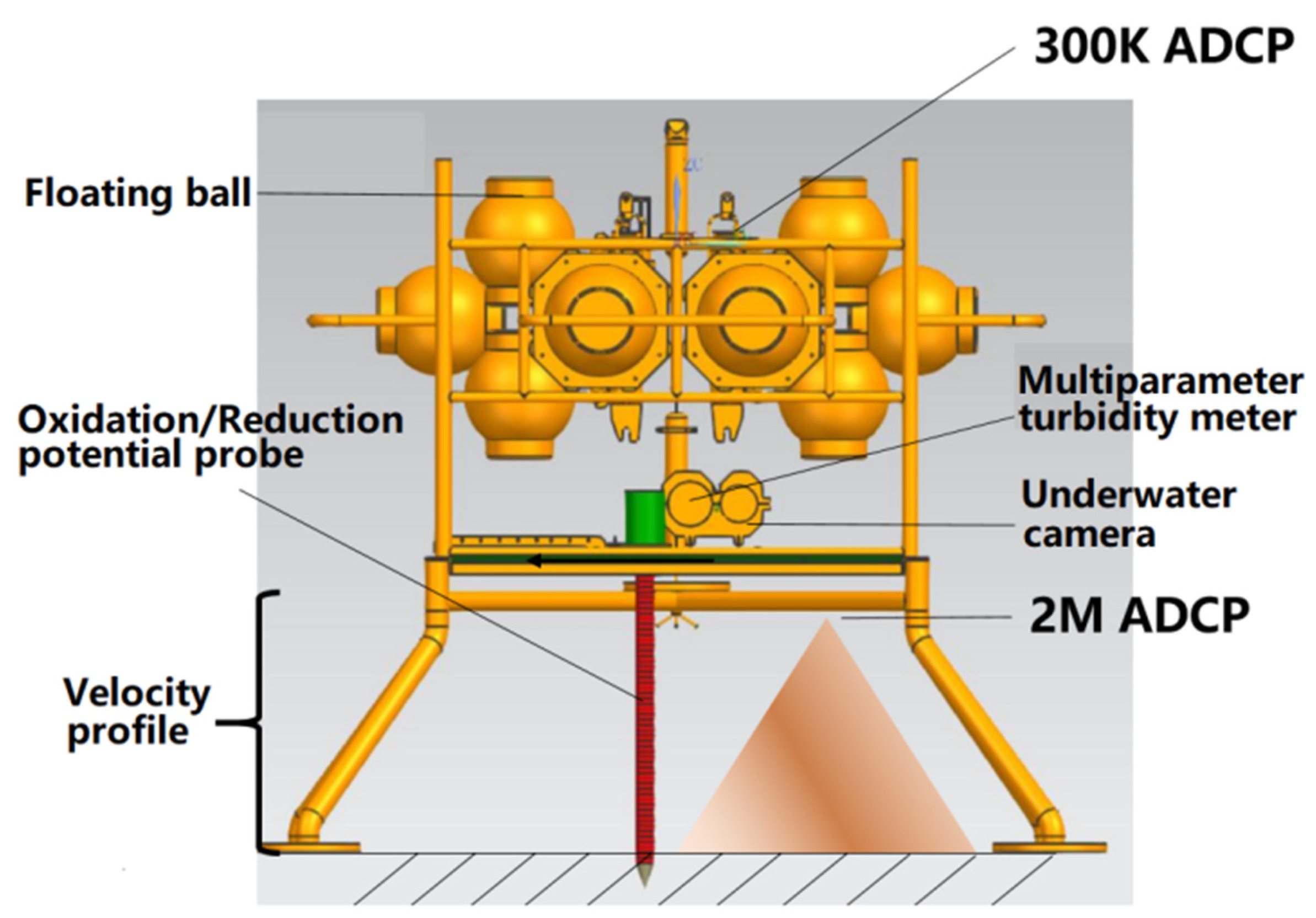

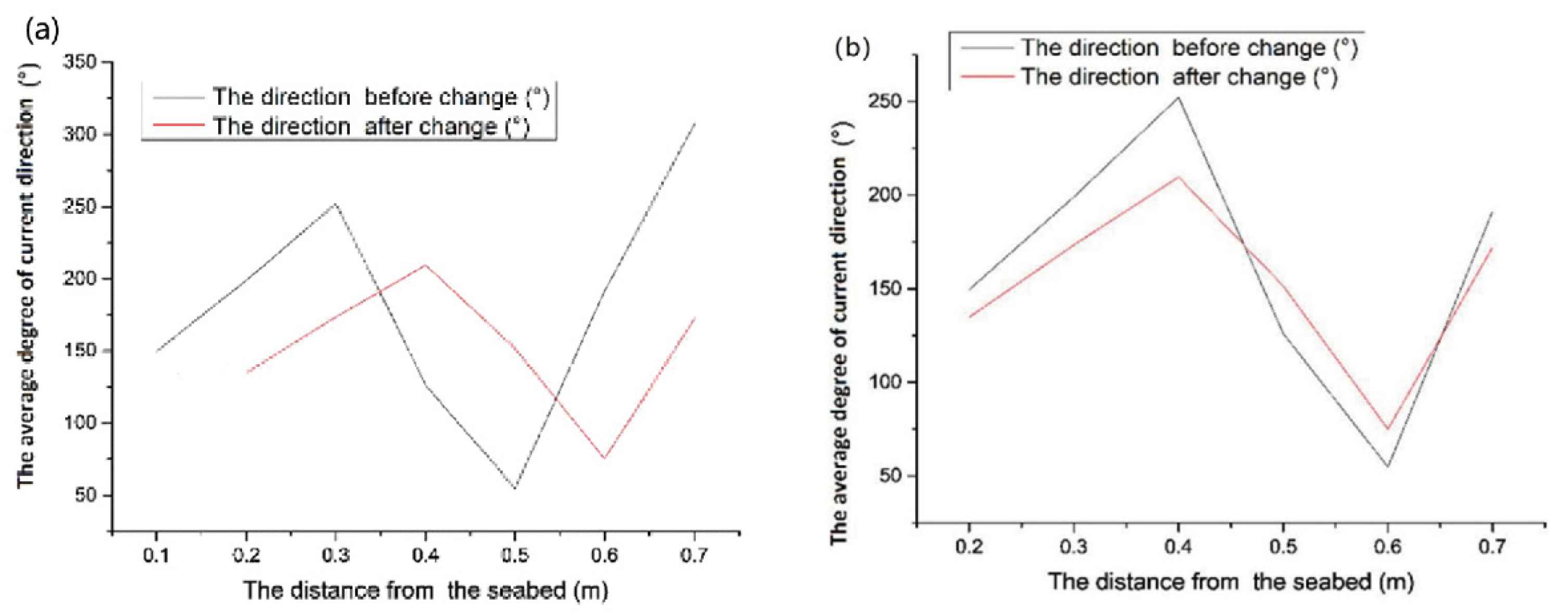

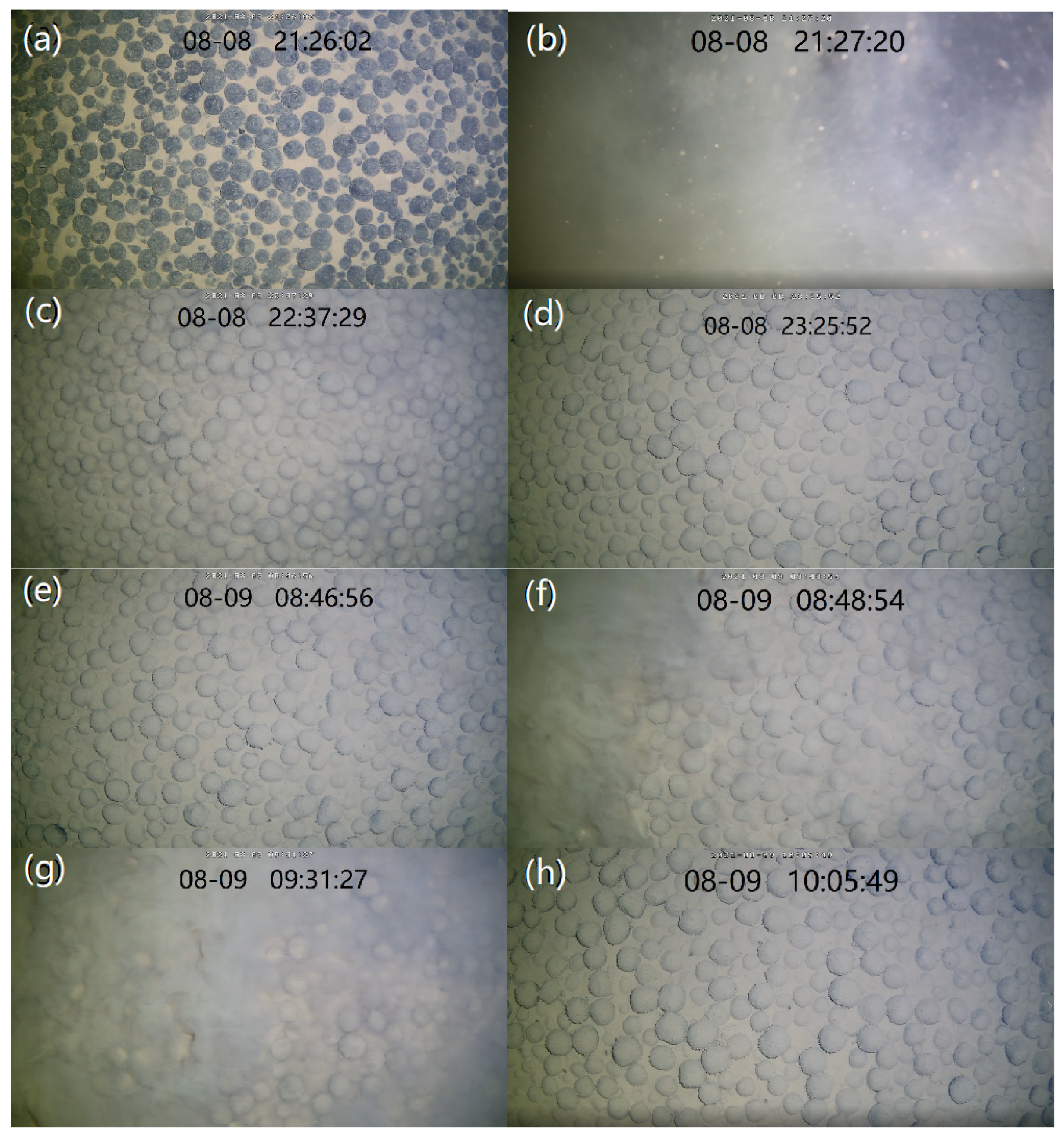
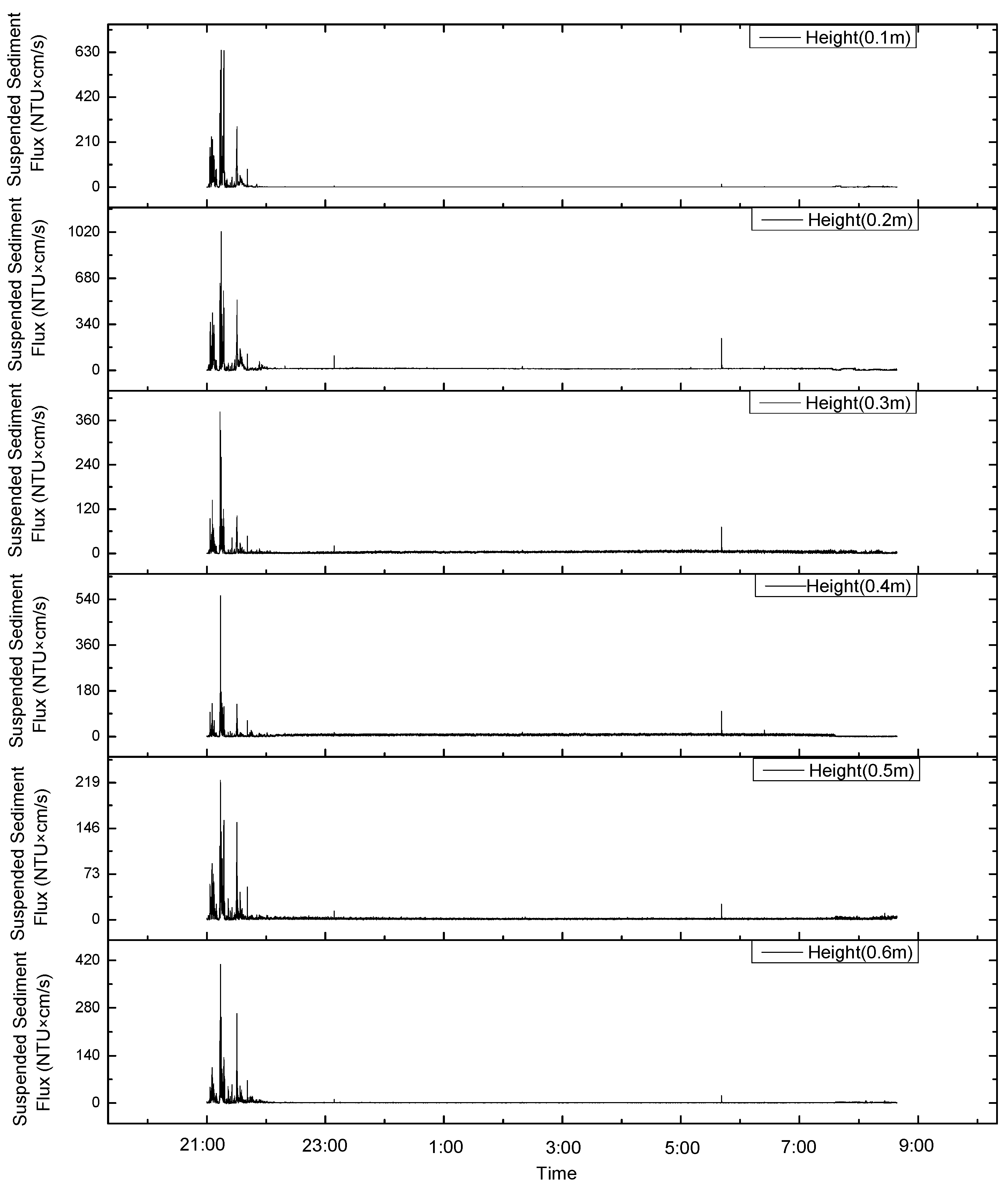
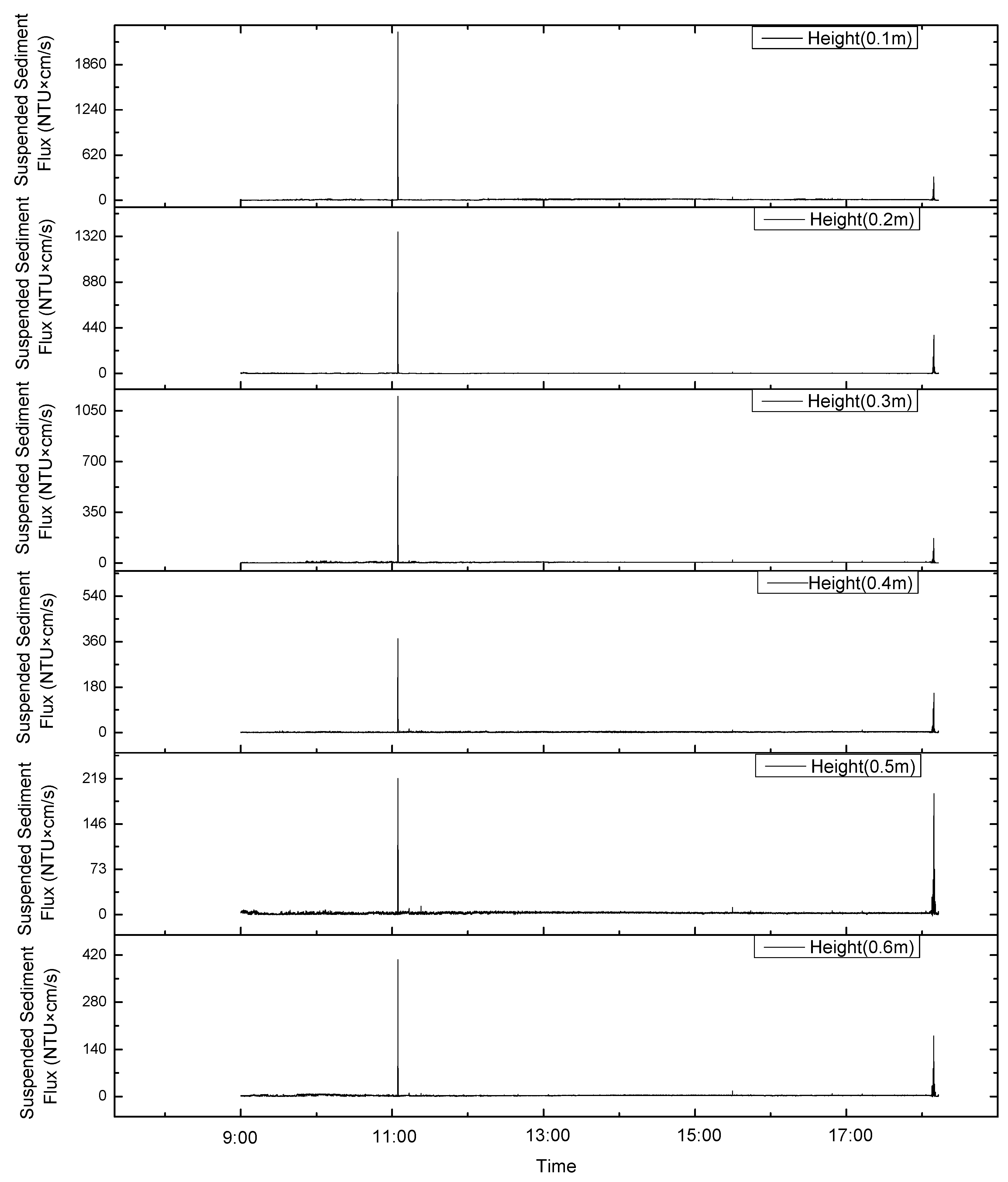
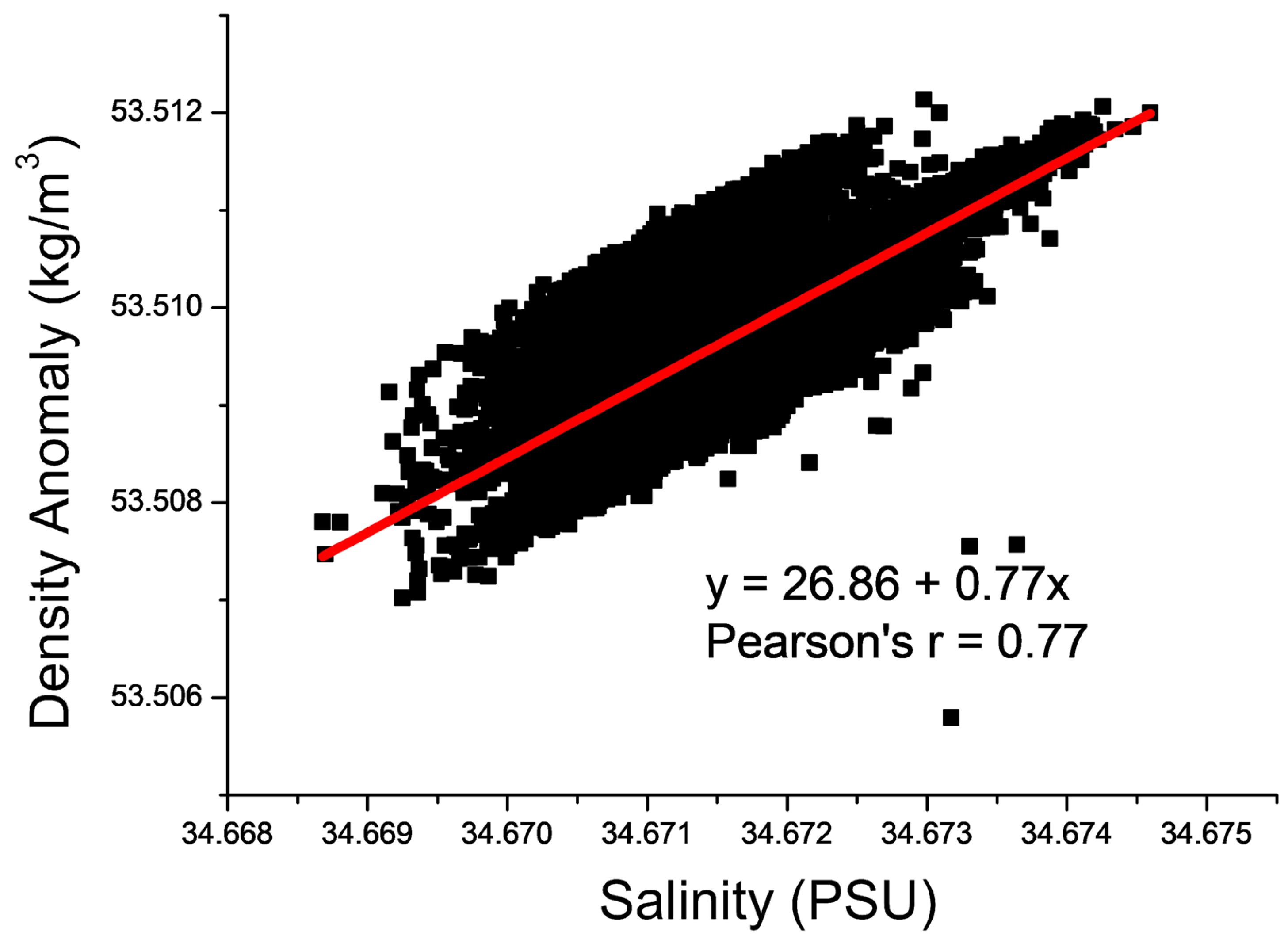
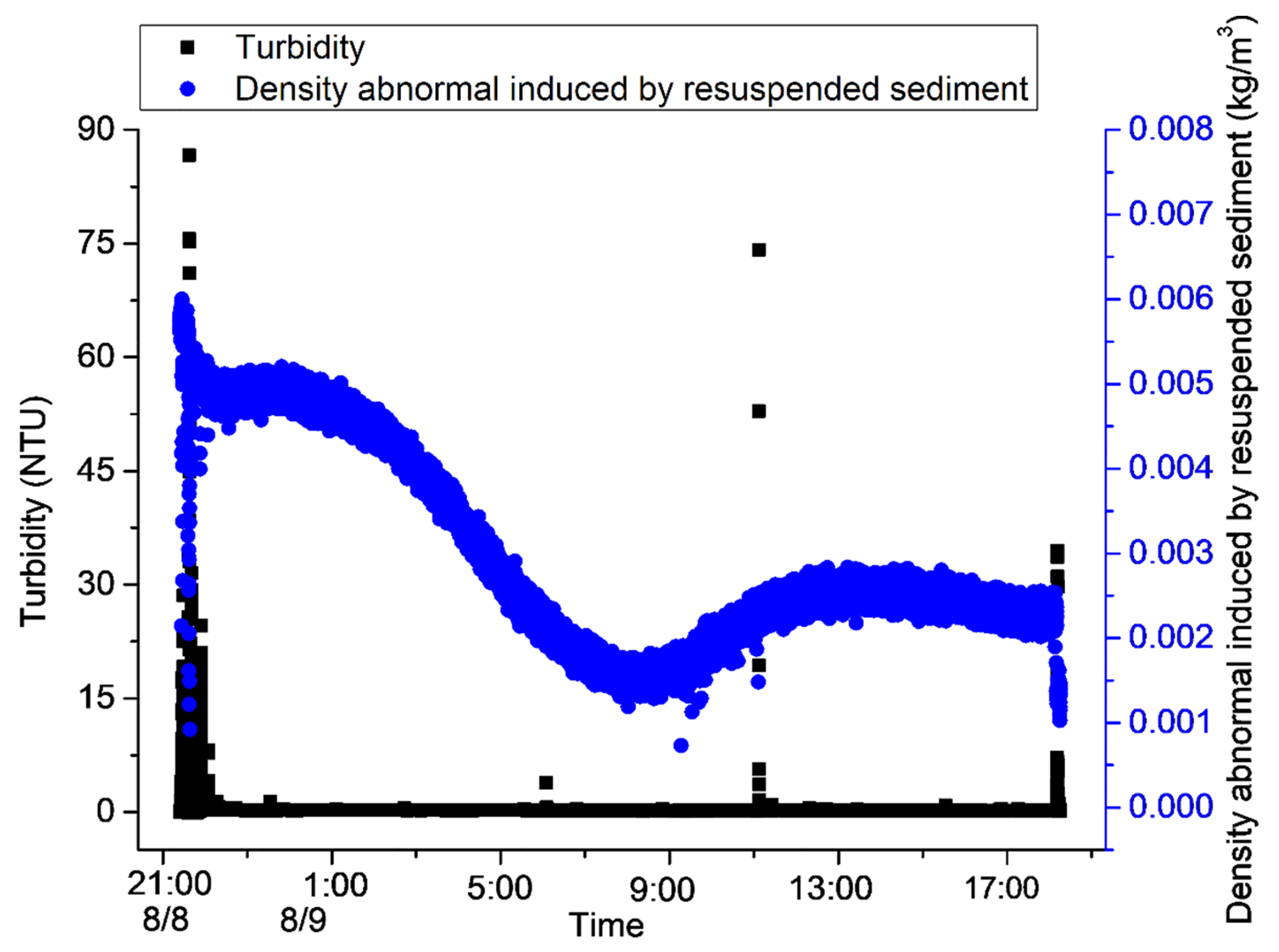

Disclaimer/Publisher’s Note: The statements, opinions and data contained in all publications are solely those of the individual author(s) and contributor(s) and not of MDPI and/or the editor(s). MDPI and/or the editor(s) disclaim responsibility for any injury to people or property resulting from any ideas, methods, instructions or products referred to in the content. |
© 2023 by the authors. Licensee MDPI, Basel, Switzerland. This article is an open access article distributed under the terms and conditions of the Creative Commons Attribution (CC BY) license (https://creativecommons.org/licenses/by/4.0/).
Share and Cite
Li, B.; Jia, Y.; Fan, Z.; Li, K.; Shi, X. Impact of the Mining Process on the Near-Seabed Environment of a Polymetallic Nodule Area: A Field Simulation Experiment in a Western Pacific Area. Sensors 2023, 23, 8110. https://doi.org/10.3390/s23198110
Li B, Jia Y, Fan Z, Li K, Shi X. Impact of the Mining Process on the Near-Seabed Environment of a Polymetallic Nodule Area: A Field Simulation Experiment in a Western Pacific Area. Sensors. 2023; 23(19):8110. https://doi.org/10.3390/s23198110
Chicago/Turabian StyleLi, Bowen, Yonggang Jia, Zhihan Fan, Kai Li, and Xuefa Shi. 2023. "Impact of the Mining Process on the Near-Seabed Environment of a Polymetallic Nodule Area: A Field Simulation Experiment in a Western Pacific Area" Sensors 23, no. 19: 8110. https://doi.org/10.3390/s23198110
APA StyleLi, B., Jia, Y., Fan, Z., Li, K., & Shi, X. (2023). Impact of the Mining Process on the Near-Seabed Environment of a Polymetallic Nodule Area: A Field Simulation Experiment in a Western Pacific Area. Sensors, 23(19), 8110. https://doi.org/10.3390/s23198110






